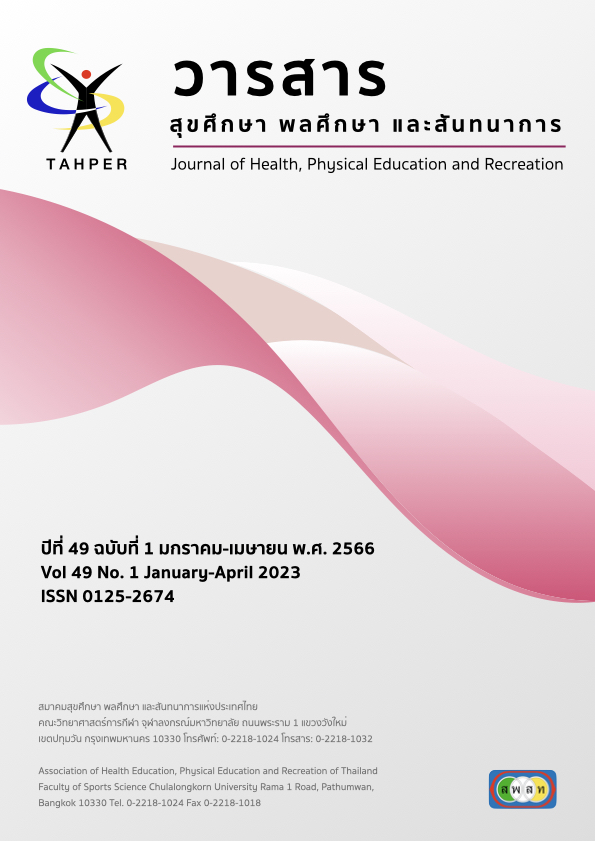Using Learning and Innovation Skills in Teaching of Physical Education Teachers under the Secondary Education Service Area Office 3 Phra Nakhon Si Ayutthaya Province
Main Article Content
Abstract
The purpose of this research was to study the use of learning and innovation skills in teaching of physical education teachers under the secondary education service area office 3 Phra Nakhon Si Ayutthaya Province. There were 71 respondents to the questionnaire, accounting for 88.75 percent, and 11 collaborators participating in the group discussion, accounting for 15.49 percent. The statistics used in this study were frequency, percentage, average and standard deviation.
The results as follows: 1) The teaching of physical education to develop critical thinking, communication collaboration and creativity in general, the level of practice is often. 2) Teaching management to improve critical thinking includes problem solving methods, analyze problems together, co-designing the practice model and brainstorming. Teaching management to improve communication includes opportunities for asking questions, group activities that are discussed, group planning and presentation in front of the class. Teaching management to improve collaboration includes organizing fun and challenging activities, promoting acceptance and consideration of differences, setting common goals and kindness to help each other. Teaching management to improve creative thinking includes flexible atmosphere arrangement and having students design training postures that are built on basic skills. The creation of works and teachers are accepting and giving advice.
Article Details

This work is licensed under a Creative Commons Attribution-NonCommercial-NoDerivatives 4.0 International License.
Critical thinking in journals is the right of the author. The Association of Health Education, Physical Education and Recreation of Thailand is not always required, to create diversity in ideas and creativity.
ความคิด ข้อวิพากษ์ในวารสารเป้นสิทธิของผู้เขียน สมาคมสุขศึกษา พลศึกษา และสันทนาการแห่งประเทศไทยไม่จำเป็นต้องเห็นชอบด้วยเสมอไป เพื่อให้เกิดความหลากหลายในความคิดและความสร้างสรรค์
References
กรมสุขภาพจิต. (2544). คู่มือการดูแลผู้มีปัญหาสุขภาพจิตและจิตเวชสำหรับแพทย์ (ปรับปรุง) 2544. กรุงเทพฯ: บริษัท เรดิเอชั่น จำกัด.
พงษ์เอก สุกใส. (2561). ครูพลศึกษาในศตวรรษที่ 21 Physical Education Teacher in the 21st Century. วารสารวิชาการมหาวิทยาลัยฟาร์อีสเทอร์น, 12(Supplement), 8-12.
วาสนา คุณาอภิสิทธิ์. (2539). การสอนพลศึกษา. กรุงเทพฯ: บริษัท วิทยพัฒน์ จำกัด.
วิภาวี เกียรติอัชฌาลัย. (2542). เปรียบเทียบผลการปรึกษาเชิงจิตวิทยาแบบกลุ่มตามแนวทฤษฎีของโรเจอร์สและกิจกรรมกลุ่มที่มีต่อการพัฒนาอัตมโนทัศน์ของนักศึกษา คณะพยาบาลศาสตร์ มหาวิทยาลัยเชียงใหม่ (วิทยานิพนธ์ปริญญาศึกษาศาสตรมหาบัณฑิต). เชียงใหม่: มหาวิทยาลัยเชียงใหม่.
สำนักวิชาการและมาตรฐานการศึกษา. (2551). ตัวชี้วัดและสาระการเรียนรู้แกนกลาง กลุ่มสาระการเรียนรู้สุขศึกษาและพลศึกษา ตามหลักสูตรแกนกลางการศึกษาขั้นพื้นฐาน พุทธศักราช 2551. กรุงเทพฯ: สำนักงานคณะกรรมการการศึกษาขั้นพื้นฐาน กระทรวงศึกษาธิการ.
สุมณฑา พรหมบุญ และ อรพรรณ พรสีมา. (2540). การเรียนรู้แบบมีส่วนร่วม. วารสารครุศาสตร์ จุฬาลงกรณ์มหาวิทยาลัย, 26(1), 23-24.
Cleland, F. (2011). Impacting learners through enriched physical education environments: A developmental perspective. Active and Healthy Maga- zine, 18(2), 5–13.
Johnson, T. G. (2019). The “Goods of Sport” and Physical Education. Journal of Physical Education, Recreation & Dance, 90(8), 3-5.
Pill, S and B. SueSee. (2017). Including Critical Thinking and Problem Solving in Physical Education. Journal of Physical Education, 88(9), 43-49.
Smith, H. M. (2013). Creative Expression and Physical Education. Journal of Health, Physical Education, Recreation, 33(5), 38-39.


